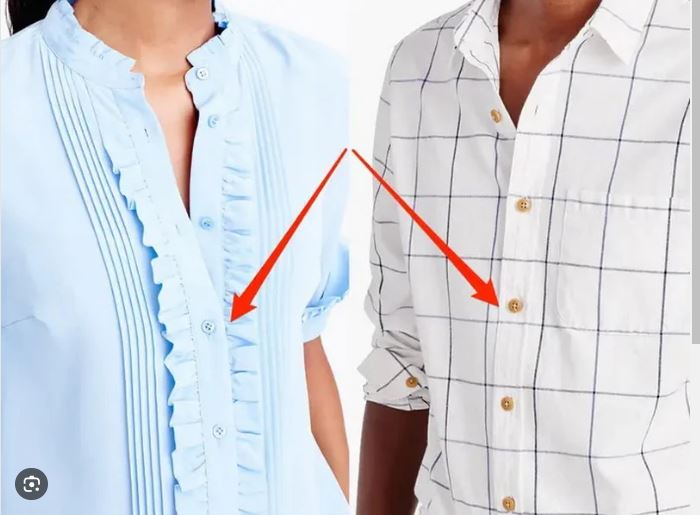Why are buttons on men’s and women’s shirts always on opposite sides?
The placement of buttons on men’s shirts on the right and women’s shirts on the left reveals the fashion context of the past and explains its continuation in contemporary fashion.
This particular fashion standard originates from the 13th century, marking an interesting blend of social status, wealth, and practicality that has persisted through various eras. Buttons, invented in the 13th century, quickly surpassed their functional purpose to become symbols of wealth and social status.

Buttons were invented in the 13th century
According to the Encyclopædia Britannica, in the 13th century, common women fastened their garments with fabric strings or wooden clasps, while middle-class and upper-class women wore elaborate outfits secured by expensive buttons made of gold, silver, pearls, gemstones, and ivory — a trend that laid the foundation for the distinction between high-end fashion and everyday fashion in the future.
Melanie M. Moore, founder of the women’s blouse brand Elizabeth & Clarke, states: “When buttons were invented in the 13th century, they were very expensive. Only upper-class women at that time wore buttoned garments. They didn’t dress themselves, but the maids would help them dress. Since most people are right-handed, the buttons would be placed on the left side for the maid who stood in front to easily button up for her lady.” Meanwhile, Thorstein Veblen’s 1899 book “Theory of the Leisure Class” also suggests that the left-side buttoning of women’s clothing is a subtle indication of her family’s affluence, a characteristic of the upper class.
What about men’s clothing? Melanie suggests that “as a general rule,” many elements of men’s fashion can be traced back to the military. The rule assumes that the majority of men are right-handed, and having buttons on the right side of their garments would make it easier for them to conceal weapons inside their shirts.
Furthermore, since ancient times when men were responsible for hunting, the motion of reaching for a weapon during hunting would typically be from left to right, thus the buttons and fasteners on men’s clothing were designed on the right side to accommodate the body’s movement. They also often carried shields on their left arm and swords in their right hand during battles. Even as times changed and weapons evolved, men’s clothing still carries the influence of military uniforms. This habit over thousands of years of warfare has accustomed men to fastening and unfastening buttons with their left hand.
Another hypothesis on the difference between men’s and women’s buttons
The above hypothesis has its grounds but some drawbacks. Upper-class men also had servants helping them with dressing, but their garments still had buttons on the right side, not like women’s clothing.
Another theory suggests that in the past, breastfeeding women usually cradled their babies with their right hand. Therefore, women had to use their left hand to unbutton their clothes. With the arrangement of buttons on the left side of the shirts, they could easily unbutton with one hand. In addition, the right flap of women’s clothing typically lacks buttons to prevent the baby from getting tangled while breastfeeding.
Furthermore, it is also argued that when mass-producing garments with sewing machines, the resulting products looked very similar. Therefore, it was necessary to clearly differentiate between men’s and women’s clothing in terms of button placement.

Buttons on men’s and women’s shirts are always on opposite sides
Historical research from the 1840s to 1850s shows a 50/50 ratio regarding women’s buttoned clothing on the right or left side. By the 1860s, clothing with buttons on the left side became more popular. This may be due to the popularity of sewing machines at that time. Clothing became more affordable, and sellers chose to imitate the upper class. Thus, the arrangement of buttons on men’s and women’s clothing on opposite sides became common from then on.
In conclusion, there is no definitive explanation and concrete evidence for the difference in button placement between men’s and women’s shirts. It may simply be a standard or a habit adopted by designers and garment-makers from centuries ago. And it has been maintained as an immutable default until now because no one complains about it, or even not everyone knows this small difference. There is no absolute and precise explanation for the issue of men’s buttons on the right and women’s buttons on the left, but nowadays, that design style is still maintained as an unchangeable standard. If someone accidentally changes the button on a women’s shirt to the right side, it will surely be considered a faulty shirt.

































